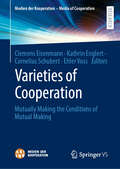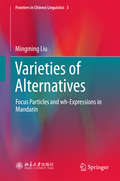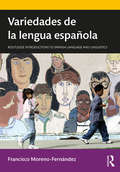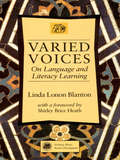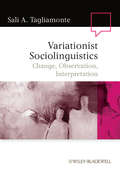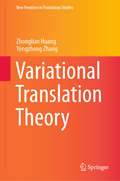- Table View
- List View
Varieties of Modern English: An Introduction
by Diane DaviesThe 'story' of English is continually re-told and re-written, as more and more people use the language and have a part in shaping the way it develops. Varieties of Modern English provides a critical introduction to the study of regional, social, gendered, context- and medium-related varieties of the language, and explores some of the debates concerning the role and impact of English in different parts of the world today. Beginning by outlining the main types of variation in language, the book focuses on the link between language or dialect and the construction of both group and individual identities. Issues of identity are crucial to chapters on the roots of Modern English, on gender and English, on ethnicity and English and on English as an international language. As well as looking at a range of 'users' of the language, Davies also explores many of its 'uses' and modes, including the English of literary texts, advertising, newspaper reporting and commentary, political speeches, email and text messaging. Written in a discursive, student-friendly style, the book also provides: * A rich mix of illustrative material * End-of-chapter Activities and related Comments at the end of the book * Suggestions for further reading Varieties of Modern English provides a thought-provoking overview of its subject and will be invaluable reading for students of English Language and Linguistics.
Varieties of Modern English: An Introduction
by Diane DaviesThe 'story' of English is continually re-told and re-written, as more and more people use the language and have a part in shaping the way it develops. Varieties of Modern English provides a critical introduction to the study of regional, social, gendered, context- and medium-related varieties of the language, and explores some of the debates concerning the role and impact of English in different parts of the world today. Beginning by outlining the main types of variation in language, the book focuses on the link between language or dialect and the construction of both group and individual identities. Issues of identity are crucial to chapters on the roots of Modern English, on gender and English, on ethnicity and English and on English as an international language. As well as looking at a range of 'users' of the language, Davies also explores many of its 'uses' and modes, including the English of literary texts, advertising, newspaper reporting and commentary, political speeches, email and text messaging. Written in a discursive, student-friendly style, the book also provides: * A rich mix of illustrative material * End-of-chapter Activities and related Comments at the end of the book * Suggestions for further reading Varieties of Modern English provides a thought-provoking overview of its subject and will be invaluable reading for students of English Language and Linguistics.
Varieties of Female Gothic Vol 5
by Gary KellyThis text offers scholarly and critical editions of significant novels of Gothic fiction from the Romantic period. It illustrates the various forms of female Gothic literature as a vehicle for representing the modern forms of subjectivity, or complex and authentic inward experience and identity.
Varieties of Female Gothic Vol 5
by Gary KellyThis text offers scholarly and critical editions of significant novels of Gothic fiction from the Romantic period. It illustrates the various forms of female Gothic literature as a vehicle for representing the modern forms of subjectivity, or complex and authentic inward experience and identity.
Varieties of Female Gothic Vol 1
by Gary KellyThis text offers scholarly and critical editions of significant novels of Gothic fiction from the Romantic period. It illustrates the various forms of female Gothic literature as a vehicle for representing the modern forms of subjectivity, or complex and authentic inward experience and identity.
Varieties of Female Gothic Vol 1
by Gary KellyThis text offers scholarly and critical editions of significant novels of Gothic fiction from the Romantic period. It illustrates the various forms of female Gothic literature as a vehicle for representing the modern forms of subjectivity, or complex and authentic inward experience and identity.
Varieties of English: An Introduction to the Study of Languages (Studies in English Language)
by Dennis Freeborn David Langford Peter FrenchVarieties of English: An Introduction to the Study of Language (Studies in English Language)
by David Langford Peter FrenchThis new edition of the best selling, topic-based introduction to spoken and written English, is now fully revised and expanded with over 50% more material. This practical volume provides a wide range of written texts and transcriptions of speech for commentary and analysis. There are further practical activities and new sections on areas such as 'politically correct' usage.
Varieties Of English: A Typological Approach
by Peter SiemundEnglish is a highly diversified language that appears in a multitude of different varieties across the globe. These varieties may differ extensively in their structural properties. This coursebook is an introduction to the fascinating range of regional and social varieties encountered around the world. Comparing grammatical phenomena, the book analyses the varieties in depth, identifying patterns and limits of variation, and providing clear explanations. Using comparisons with other languages, the book identifies universal as well as language-specific aspects of variation in English. This book is specially designed to meet the needs of students, each chapter contains useful exercises targeted at three different ability levels and succinct summaries and practical lists of key words help students to review and identify important facts.
Varieties of Cooperation: Mutually Making the Conditions of Mutual Making (Medien der Kooperation – Media of Cooperation)
by Clemens Eisenmann Kathrin Englert Cornelius Schubert Ehler VossThis volume conceives cooperation in broad terms as any form of mutual making, in which goals, means, and procedures are seen as ongoing accomplishments. From the exchanges of goods or information, to the interactions between bodies or organizations, and the coordination between colleagues, competitors, friends or foes. Mutually making the conditions of mutual making entails translating heterogeneous interests, negotiating conflicting values and articulating distributed activities. On the one hand, the contributions cover different notions and concepts of cooperation in diverse fields of study: from the mundane cooperation of everyday life to collective endeavors within specific domains. On the other hand, the contributions share a focus on the practices of making cooperation possible through cooperatively creating the conditions for cooperation itself. Seeing cooperative media both as a condition and consequence of cooperation, the volume sheds light on a general feature of media, technologies and instruments that both enable and constrain the collaboration between heterogeneous social worlds, with and without consensus. Chapter 7 “The Passport as a Medium of Movement” is available open access under a Creative Commons Attribution 4.0 International License via SpringerLink.
Varieties of Contemporary French (Contemporary Language Studies)
by Malcolm OffordWhat is French? Where is it spoken? Who speaks it? How is it spoken? These are some of the questions which this book attempts to answer. It explores the many varieties of French and demonstrates that the choice of a particular variety depends upon a number of factors - some relating to the actual speaker, her/his age, sex, socio-economic status and place of origin, others to the nature of the situation producing the variety. Special attention is paid to geographical variation.
The Varieties of Authorial Intention: Literary Theory Beyond the Intentional Fallacy
by John FarrellThis book explores the logic and historical origins of a strange taboo that has haunted literary critics since the 1940s, keeping them from referring to the intentions of authors without apology. The taboo was enforced by a seminal article, “The Intentional Fallacy,” and it deepened during the era of poststructuralist theory. Even now, when the vocabulary of “critique” that has dominated the literary field is under sweeping revision, the matter of authorial intention has yet to be reconsidered. This work explains how “The Intentional Fallacy” confused different kinds of authorial intentions and how literary critics can benefit from a more up-to-date understanding of intentionality in language. The result is a challenging inventory of the resources of literary theory, including implied readers, poetic speakers, omniscient narrators, interpretive communities, linguistic indeterminacy, unconscious meaning, literary value, and the nature of literature itself.
The Varieties of Authorial Intention: Literary Theory Beyond the Intentional Fallacy
by John FarrellThis book explores the logic and historical origins of a strange taboo that has haunted literary critics since the 1940s, keeping them from referring to the intentions of authors without apology. The taboo was enforced by a seminal article, “The Intentional Fallacy,” and it deepened during the era of poststructuralist theory. Even now, when the vocabulary of “critique” that has dominated the literary field is under sweeping revision, the matter of authorial intention has yet to be reconsidered. This work explains how “The Intentional Fallacy” confused different kinds of authorial intentions and how literary critics can benefit from a more up-to-date understanding of intentionality in language. The result is a challenging inventory of the resources of literary theory, including implied readers, poetic speakers, omniscient narrators, interpretive communities, linguistic indeterminacy, unconscious meaning, literary value, and the nature of literature itself.
Varieties of Alternatives: Focus Particles and wh-Expressions in Mandarin (Frontiers in Chinese Linguistics #3)
by Mingming LiuThis book concerns two focus particles (jiu, dou) and wh-expressions (shenme = ‘what’, na geren = ‘which person’) in Mandarin Chinese. These items are systematically ‘ambiguous’ and have played important roles in various aspects of Mandarin grammar. An idea based on alternatives and varieties of alternatives in particular – following Chierchia’s 2013 analysis of the polarity system – is pursued to account for the systematic ambiguities. The unambiguous semantics of jiu, dou and wh-expressions are maintained and ‘ambiguity’ explained through varieties of alternatives interacting with other independently motivated aspects of the structure they occur in. By examining these aspects in detail, the book will help readers gain a better understanding of a broad range of phenomena that involve these items – including exhaustivity, distributivity, questions and conditionals.
Variedades de la lengua española
by Francisco Moreno-FernándezVariedades de la lengua española ofrece un panorama general de la variación dialectal y sociolingüística en el espacio hispanohablante, presentado por uno de los más prestigiosos expertos en la materia. La lectura de este manual permitirá familiarizarse con los rasgos que distinguen las diferentes variedades geográficas del español, con una comprensión adicional de las causas históricas y políticas de sus diferencias y de sus implicaciones sociales. Cada capítulo incluye sugerencias de lecturas complementarias y propone temas de debate e investigación, así como un glosario que explica la terminología algo más especializada. Complementariamente, el texto remite a materiales audiovisuales disponibles en la red que permiten una aproximación más directa a las variedades del español. Estas páginas son de interés tanto para los hispanohablantes nativos como para los no nativos interesados por la diversidad dialectal. Asimismo, esta obra puede servir como texto primario, de apoyo o complementario para los estudiantes, el profesorado y los hispanistas interesados por el conocimiento de las variedades geográficas y sociales de la lengua española.
Variedades de la lengua española
by Francisco Moreno-FernándezVariedades de la lengua española ofrece un panorama general de la variación dialectal y sociolingüística en el espacio hispanohablante, presentado por uno de los más prestigiosos expertos en la materia. La lectura de este manual permitirá familiarizarse con los rasgos que distinguen las diferentes variedades geográficas del español, con una comprensión adicional de las causas históricas y políticas de sus diferencias y de sus implicaciones sociales. Cada capítulo incluye sugerencias de lecturas complementarias y propone temas de debate e investigación, así como un glosario que explica la terminología algo más especializada. Complementariamente, el texto remite a materiales audiovisuales disponibles en la red que permiten una aproximación más directa a las variedades del español. Estas páginas son de interés tanto para los hispanohablantes nativos como para los no nativos interesados por la diversidad dialectal. Asimismo, esta obra puede servir como texto primario, de apoyo o complementario para los estudiantes, el profesorado y los hispanistas interesados por el conocimiento de las variedades geográficas y sociales de la lengua española.
Varied Voices: On Language and Literacy Learning
by Linda Lonon Blanton"I can say with certainty that this book will add a compelling sense of depth and texture to the existing body of research in first and second language literacy." --Patricia Richard-Amato, California State University at Los Angeles Varied Voices is an ethnographic study of language and literacy learning in a culturally and linguistically diverse Moroccan school. There, children and teachers turn classrooms into social spaces as they work to build learning communities. Suitable for MATESOL courses and in-service training, Varied Voices is a must-read for all instructors working with language minority students at the elementary and secondary school levels.
Varied Voices: On Language and Literacy Learning
by Linda Lonon Blanton"I can say with certainty that this book will add a compelling sense of depth and texture to the existing body of research in first and second language literacy." --Patricia Richard-Amato, California State University at Los Angeles Varied Voices is an ethnographic study of language and literacy learning in a culturally and linguistically diverse Moroccan school. There, children and teachers turn classrooms into social spaces as they work to build learning communities. Suitable for MATESOL courses and in-service training, Varied Voices is a must-read for all instructors working with language minority students at the elementary and secondary school levels.
Variationist Sociolinguistics: Change, Observation, Interpretation (Language in Society #39)
by Sali A. TagliamonteVariationist Sociolinguistics: Change, Observation, Interpretation presents a comprehensive, intermediate level examination of Language Variation and Change, the branch of sociolinguistics concerned with linguistic variation in spoken and written language. Represents the most up-to-date coverage of the history, developments, and methodologies of variationist sociolinguistics Addresses all aspects of linguistic variation, including areas not usually covered in introductory texts, e.g. the phonological, morpho-syntactic, discourse/pragmatic Outlines comparative sociolinguistic approach, data collection, methodological issues; and addresses state-of-the-art contemporary quantitative methods and statistical practice Features cutting-edge research at an appropriate level to facilitate student learning Engages students throughout with a variety of pedagogical features, including Mini Quizzes to test comprehension, extensive Exercises at the end of each chapter, the opportunity to do hands-on quantitative analysis of a never-before published data set, and Notes and Tips that offer insight into conducting sociolinguistic research. Extra materials and answers to the exercises are available at www.wiley.com/go/tagliamonte
Variationist Sociolinguistics: Change, Observation, Interpretation (Language in Society #38)
by Sali A. TagliamonteVariationist Sociolinguistics: Change, Observation, Interpretation presents a comprehensive, intermediate level examination of Language Variation and Change, the branch of sociolinguistics concerned with linguistic variation in spoken and written language. Represents the most up-to-date coverage of the history, developments, and methodologies of variationist sociolinguistics Addresses all aspects of linguistic variation, including areas not usually covered in introductory texts, e.g. the phonological, morpho-syntactic, discourse/pragmatic Outlines comparative sociolinguistic approach, data collection, methodological issues; and addresses state-of-the-art contemporary quantitative methods and statistical practice Features cutting-edge research at an appropriate level to facilitate student learning Engages students throughout with a variety of pedagogical features, including Mini Quizzes to test comprehension, extensive Exercises at the end of each chapter, the opportunity to do hands-on quantitative analysis of a never-before published data set, and Notes and Tips that offer insight into conducting sociolinguistic research. Extra materials and answers to the exercises are available at www.wiley.com/go/tagliamonte
Variational Translation Theory (New Frontiers in Translation Studies)
by Zhonglian Huang Yongzhong ZhangThis book, adopting the perspective of cross-cultural communication, theoretically justifies and addresses human variational translation practice for the first time in the area of translation studies, focusing on the adaptation techniques and variational translation methods, as well as general features and laws of the variational translation process. It classifies and summarizes seven main adaptation techniques and eleven translation methods applicable to all variational translation activities. These techniques and methods, quite different from those used in complete translation or full translation, are systematically studied together with examples, allowing readers to not only understand their interrelations and differences within the context of variational translation methods, but also to master them in order to improve their translation efficacy and efficiency. Readers will gain a better understanding of how variational translation is produced, and of its important role in advancing cross-cultural communication and in reconstructing human knowledge and culture. This book is intended for translation scholars, translation practitioners, students, and others whose work involves the theory and practice of translation and who want to enhance their translation proficiency in cross-cultural communication for the Information Age.
The Variation Theory of Comparative Literature
by Shunqing CaoSeeing the restrictions of former studies in Comparative Literature and aiming to amend these deficiencies, the author of this book mainly discusses the major theoretical significance and academic value of the Variation Theory in the whole process of the development of Comparative Literature in the world. In China the seminal comparative study of literature among different cultures can be dated back to ancient China, while the founding of comparative literature as a distinct academic discipline has to be largely owing to the influence of the West. The modern Chinese study of comparative literature formed its uniqueness under Western influence. The direct influence of the translation of western theories into China is remarkable. However, in the course of translation and reception of Western theories, Chinese comparatists and intellectuals have been encountering various problems, and solving them with an alternative method accordingly different from the traditional methods proposed by the French School and the American School. Therefore, in this book, modern Chinese study of comparative literature is put in a historical context with regard to the theoretical issue of the discipline in China through the entire 20th century. At present, many scholars in China and in other countries agree that, with the influence study proposed by the French School and the study of analogy advocated by the American School, the entire theoretical system of Comparative Literature is well built. However, when the comparative study of literature between East and West is concerned, the theory of Comparative Literature is far from perfect. It is not only because many problems still exist, but there are significant defects in their theoretical bases respectively. Many researches have proven that even with the influence study and the study of analogy, we still can not solve many problems in the practice of studies in comparative literature. This does not mean that we have no respect for the contributions of the French School and the American School; we just want to attach importance to literary variations, which is a phenomenon that has long been neglected. The purpose of putting forward the Variation Theory in Comparative Literature is to provide new perspectives, new methods and new theory to the study of comparative literature, which may be a major breakthrough in the international arena of Comparative Literature. The neglect of literary variation is mainly because all the previous theories about comparative literature start off in search of similarities but not differences. Accordingly, in 1990s heterogeneity as a premise of comparability was put forward. And later, the variation theory was further advanced. It is not only the important phenomenon in literary communication, but also the most valuable research object in Comparative Literature. Still, it will be an important path to cultural innovation. The Variation Theory may make up the major flaws of theories by both French school and the American School since it focus on heterogeneity and variability in cross-cultural literary events, especially the ones of inter-civilization which will be a new course for comparative literature. Throughout the history of literature and the history of literary communication, collisions between different civilizations have always been producing new literary events which make the heterogeneity of different civilizations and variability traceable. The higher stage of literary communication may mean dialogue and blend between different cultures. The overarching concerns of this book include different levels of variation in literary communication and the studies of different objects. The introduction begins with a literature review of major achievements made by the French School and the American School with pointing out what they have neglected. The body of the book is divided into three parts. In the first part, Chapter 1 deals with the major contributions of influence study and its weaknesses. The origination of comparative literature in most of European countrie
Variation in the Input: Studies in the Acquisition of Word Order (Studies in Theoretical Psycholinguistics #39)
by Merete Anderssen, Kristine Bentzen and Marit WestergaardThe topic of variation in language has received considerable attention in the field of general linguistics in recent years. This includes research on linguistic micro-variation that is dependent on fine distinctions in syntax and information structure. However, relatively little work has been done on how this variation is acquired. This book focuses on how different types of variation are expressed in the input and how this is acquired by young children. The collection of papers includes studies of the acquisition of variation in a number of different languages, including English, German, Greek, Italian, Korean, Norwegian, Swiss German, Ukrainian, and American Sign Language. Different kinds of linguistic variation are considered, ranging from pure word order variation to optionally doubly filled COMPs and the resolution of scopal ambiguities. In addition, papers in the volume deal with the extreme case of variation found in bilingual acquisition.








